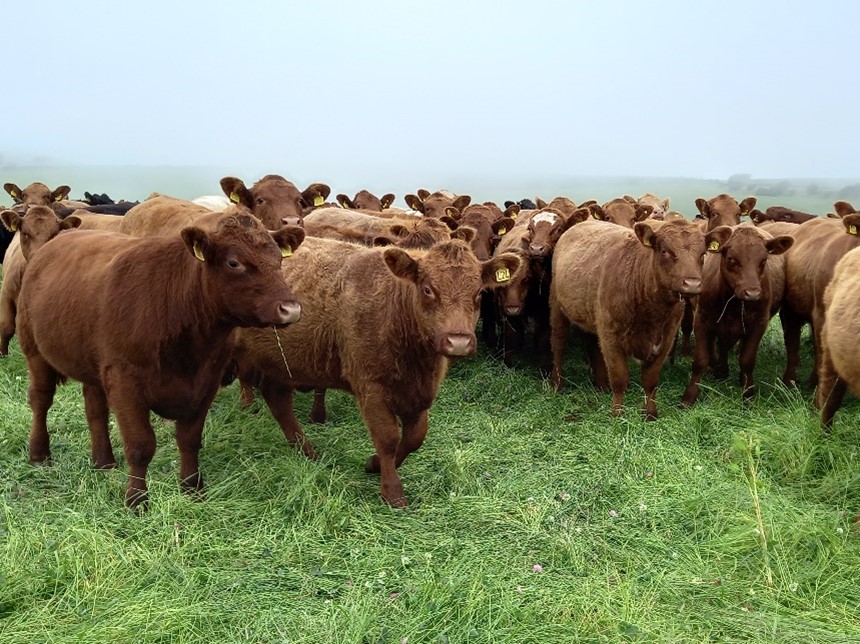Finishing Cattle at Grass and when to Supplement
6 July 2023This is part of the FAS Beef Technical Toolkit series, designed to give farmers practical timely advice to aid decision-making throughout the year.
If cattle are coming out of the winter period heavier than 450-500kg they will be going into their finishing period. Decisions on whether that is at grass or intensively finished in the shed will vary from farm to farm, this guide will help with decision making of finishing cattle at grass and when to supplement.
Considerations for finishing cattle at grass:
- The type of cattle and target growth rates
- The amount of grass and other feeds available on farm
- The growing season and grassland management
How cattle perform at grass will be determined on the quality and quantity of the grass that is in front of them. Grass that is overgrown or stemmy will be much lower in digestibility than lush, shorter grass. It is a balance between maintaining grass quality and getting enough dry matter into the cattle to provide energy for maintenance and their weight gain.
For 450-500kg cattle to be finished off grass over the summer months, target weight gains will need to be upwards of 1kg/day. This may be achievable for the first half of the grazing season on good quality, well managed swards, for example in a rotational grazing system, but will be less likely as the season progresses or on poorer pasture. Good weight gains from pasture alone are harder to achieve and needs investment in good grassland management.
When to supplementary feed finishing cattle at grass
As summer progresses the quantity and nutritional quality of grass declines. The rate at which this happens depends on many factors such as the weather, age of the sward and how it has been managed. If swards are overgrown and stemmy then digestibility and energy decline. To maintain weight gains for finishing cattle it will be necessary to supplement the grazing at this stage. The alternative is to remove cattle from grass and finish indoors.

It is important to note that the timing of supplementation will vary from farm to farm and year on year. Later in the season if grass remains plentiful and of good quality in some areas cattle could still be gaining up to 0.8kg/day. However, this requires good growing conditions and very well managed grazing. It is unlikely that cattle will gain enough to finish on grass alone at this stage.
Options when grass quality/quantity declines:
- Supplementary feed daily
- Ad-lib hoppers in fields
- House cattle and finish indoors
Supplementary feed daily
As a simple rule of thumb when feeding concentrates alongside grass – if grass is plentiful but declining feed concentrates at 0.5kg per 100kg live weight. Where grass supply is moderate or poor, feeding concentrates at 1kg per 100kg live weight. The composition of the concentrate should be high in energy and moderate for protein - around 13-14% crude protein on a fresh basis is sufficient and no more than 0.5kg per 100kg live weight is fed in a single feed, i.e. 1kg/100kg liveweight feeding rate per day would be best split into twice a day feeding.
Adlib feeding in field
If grass is poor and weight gains will be suffering, adlib hoppers with concentrate feeding can be used if housing is not available or as a cheaper alternative to housing. Where adlib hoppers are introduced into fields, ensure that cattle have been used to being trough fed and work up to adlib feeding. For home-mixes, balance cereals with protein and minerals and consider using a digestible fibre feed (such as sugar beet pulp or soya hulls) to start with to dilute the cereals. This will make it safer while cattle are transitioning on to adlib cereal based rations. Take care to introduce feeding slowly and ensure hoppers do not run out thereafter to avoid cattle gorging. Seek nutritional advice for the type of concentrate to feed. Where grass is poor it is advisable to have a covered ring of straw available as long roughage. This is especially important in inclement weather when cattle will tend to congregate round a feeder or shelter rather than graze as they will not be eating enough long roughage to keep their rumen working correctly.
Bringing them in the house to finish intensively may also be an option on some farms to keep finishing cattle on track rather than going backwards at grass.
Key considerations:
Be realistic about what the cattle weight gains are likely to be at grass on your farm. Think about what the aims of the cattle are and if this is achievable at grass on your farm.
Aim to have grass at 6-8cm to keep it high energy and digestible, for rotational grazing enter the paddock at around 10cm and exit it at around 6cm.
Sign up to the FAS newsletter
Receive updates on news, events and publications from Scotland’s Farm Advisory Service
